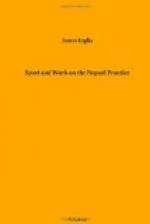In many cases by careful management, by remeasuring lands, settling doubtful boundaries, and generally working up the estate, you can much increase the rental, and actually make a profit on your bargain with the landlord. This department of indigo work is called Zemindaree. Having, then, got the village in lease, you summon in all your tenants; shew them their rent accounts, arrange with them for the punctual payment of them, and get them to agree to cultivate a certain percentage of their land in indigo for you.
This percentage varies very considerably. In some places it is one acre in five, in some one in twenty. It all depends on local circumstances. You select the land, you give the seed, but the ryot has to prepare the field for sowing, he has to plough, weed, and reap the crop, and deliver it at the factory. For the indigo he gets so much per acre, the price being as near as possible the average price of an acre of ordinary produce: taking the average out-turn and prices of, say, ten years. It used formerly to be much less, but the ryot nowadays gets nearly double for his indigo what he got some ten or fifteen years ago, and this, although prices have not risen for the manufactured article, and the prices of labour, stores, machinery, live stock, etc., have more than doubled. In some parts the ryot gets paid so much per bundle of plants delivered at the vats, but generally in Behar, at least in north Behar, he is paid so much per acre or Beegah. I use the word acre as being more easily understood by people at home than Beegah. The Beegah varies in different districts, but is generally about two-thirds of an acre.
When his rent account, then, comes to be made out, the ryot gets credit for the price of his indigo grown and delivered; and this very often suffices, not only to clear his entire rent, but to leave a margin in hard cash for him to take home. Before the beginning of the indigo season, however, he comes into the factory and takes a cash advance on account of the indigo to be grown. This is often a great help to him, enabling him to get his seeds for his other lands, perhaps ploughs, or to buy a cart, or clothes for the family, or to replace a bullock that may have died; or to help to give a marriage portion to a son or daughter that he wants to get married.
You will thus see that we have cultivation to look after in all the villages round about the factory which we can get in lease. The ryot, in return for his cash advance, agrees to cultivate so much indigo at a certain price, for which he gets credit in his rent. Such, shortly, is our indigo system. In some villages the ryot will estimate for us without our having the lease at all, and without taking advances. He grows the indigo as he would grow any other crop, as a pure speculation. If he has a good crop, he can get the price in hard cash from the factory, and a great deal is grown in this way in both Purneah and Bhaugulpore. This is called Kooskee, as against the system of advances, which is called Tuccaree.




